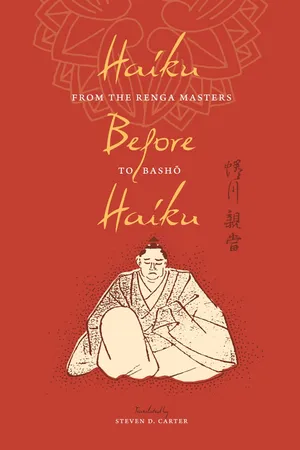![]()
![]()
The Nun Abutsu
1 Composed on her way to the East
Country, on the last day of the Ninth Month, when people planning a linked-verse party asked her for a hokku
Here we are,
already—on the day
autumn ends.
2 Composed when the same people asked for another hokku the next day
Here we are,
again—on the day
winter begins.
Mushō
3 Composed upon the request of Fujiwara no Tameuji at the temple of Ryūshin Shōnin in Fukakusa
Cry out, then, cry—
crickets in the heavy dew
of Fukakusa.
Died 1283. Court lady and founder of the Reizei lineage.
AUTUMN Kyō wa haya aki no kagiri ni narinikeri (Sōgi, Azuma mondō, p. 218) ∼East Country: here, the shogunal stronghold of Kamakura. ∼Noble literati were often asked to provide first verses for sequences. ∼One source attributes this verse (and the next one) to Abutsu’s husband, Fujiwara no Tameie (1198–1275). ∼According to the lunar calendar, autumn ended on the last day of the Ninth Month.
WINTER Kyō wa mata fuyu no hajime ni narinikeri (Sōgi, Azuma mondō, p. 218) ∼According to the lunar calendar, winter began on the first day of the Tenth Month.
Buddhist monk and early renga master.
AUTUMN (dew) Nake ya nake tsuyu fukakusa no kirigirisu (Tonna, Seiashō, p. 112) ∼Fujiwara no Tameuji (1222–1286): head of the Mikohidari lineage of court poets. ∼Ryūshin Shōnin: Enkū Ryūshin (1213–1284), a Buddhist priest of the Pure Land sect associated with Shinshū’in in Fukakusa. ∼Fukakusa: a village in the Fushimi area, south of Kyoto. ∼Compare GSIS 273, by Sone no Yoshitada (fl. ca. 980–1000): Cry out, then, cry—/ crickets in your tangle / of mugwort timber! / The passing of autumn / is indeed so sad a time.
Zenna
4 Composed beneath the cherry blossoms at Takao, when two 1000-verse events were held in one day
Just a few blossoms—
a garland for the branches
of an old tree.
5 Dewdrops?
Or moonlight forming
in the grasses?
Reizei Tamesuke
6 Hazy or not,
come out of the clouds,
spring moon!
7 Frost melts—
drenching fallen leaves
in sunlight.
Buddhist monk of the Time sect and early renga master.
SPRING (cherry blossoms) Eda nokoru hana wa oiki no kazashi kana (Tsukubashū 2044) ∼Takao: a mountainous area northwest of Kyoto famous for the beauty of its foliage. ∼The “old tree” stands for the poet, who represented older conventions of linked verse that were yielding to the new ways of Nijō Yoshimoto (p. 28).
AUTUMN (dew, moon) Tsuyu wa isa tsuki koso kusa ni musubikere (Tsukubashū 2120).
1263–1328. Son of Nun Abutsu (p. 20) and Fujiwara no Tameie, court poet, and longtime resident of Kamakura, where he served as uta master and literary jack-of-all-trades.
SPRING (haze, spring moon) Kasumu to mo kumo o ba ideyo haru no tsuki (Tsukubashū 2039) ∼Haze, usually a welcome sign of spring, here impedes the view.
WINTER (frost) Shimo kiete hikage ni nururu ochiba kana (Nijō Yoshimoto, Tsukuba mondō, p. 89) ∼The word “drenching” refers (literally) to frost melting onto fallen leaves and (figuratively) to sunlight that makes the leaves sparkle.
Musō Soseki
8 Come, sing now—
don’t wait for us to wait,
cuckoo!
9 In waters
that know no summer
autumn bobs along.
Junkaku
10 Composed on the first day of the Seventh Month
Beneath a tree,
autumn wind shows itself
in a single leaf.
11 For a 100-verse sequence composed at the home of Middle Counselor Taira no Munetsune
On leaves fallen
but not yet turned—
autumn showers.
1275–1351. Buddhist priest of the Rinzai Zen sect and major cultural figure, in politics as well as in poetry, garden design, and Zen discourse.
SUMMER (cuckoo) Kitsutsu nake matsu o na machi so hototogisu (Tsukubashū 2085) ∼The cuckoo’s call was one of the harbingers of summer.
AUTUMN Natsu shiranu mizu koso aki o ukabekere (Tsukubashū 2098) ∼Water remains cool even in summer, promising autumn relief from the heat.
Disciple of Zenna (p. 22) and renga master.
AUTUMN (autumn wind) Kogakure ni akikaze misuru hitoha kana (Tsukubashū 2103) ∼The poem echoes a Chinese quotation from an early Han philosophical text, Huainanzi (Master of Huainan, 139 B.C.E.)—“See a single leaf fall, and you know the year is heading for its end”—that was well known in Japan as a proverb, often reduced to the phrase kiri hitoha (a single paulownia leaf). ∼According to the lunar calendar, autumn began on the first day of the Seventh Month. As if recognizing that fact, a passing wind shows itself in a single trembling leaf.
AUTUMN (fallen leaves, autumn showers) Someakade ochiba ni kakaru shigure kana (Tsukubashū 2135) ∼Taira no Munetsune (1294–1349): a courtier associated with the Northern Court. ∼Poetic convention had it that rain showers dyed autumn leaves, usually while still on the trees.
Gusai
12 For a 100-verse sequence composed at the monument to Musō Soseki at Tenryūji
Remember, now—
you are known for singing,
cuckoo!
13 For a 100-verse sequence at the shrine at Anrakuji
Not forgetting
the crimson of spring—
plum leaves.
14 Composed at Kayadō, Mount Kōya
On a thatched roof
it makes no sound at all—
autumn rain.
15 Composed on the night of a full moon
On such a night
only rain would not admire
the moon.
Died 1376. Buddhist monk and renga master, tutor of Nijō Yoshimoto (p. 28), and co-compiler of the first imperial anthology of linked verse, Tsukubashū (Tsukuba Collection, 1356).
SUMMER (cuckoo) Nakeba koso na wa nokorikere hototogisu (Tsukubashū 2086) ∼Musō Soseki (p. 24). ∼Tenryūji: a major ...

